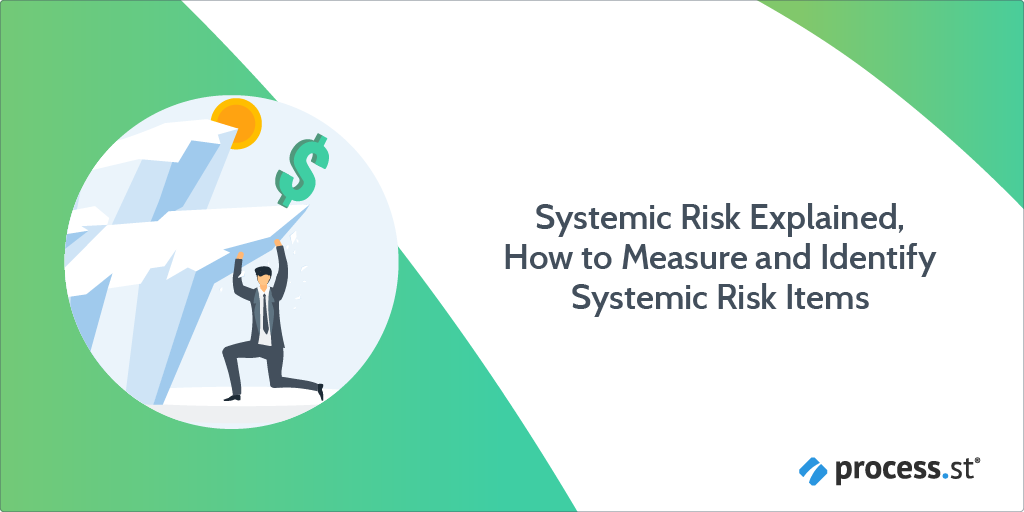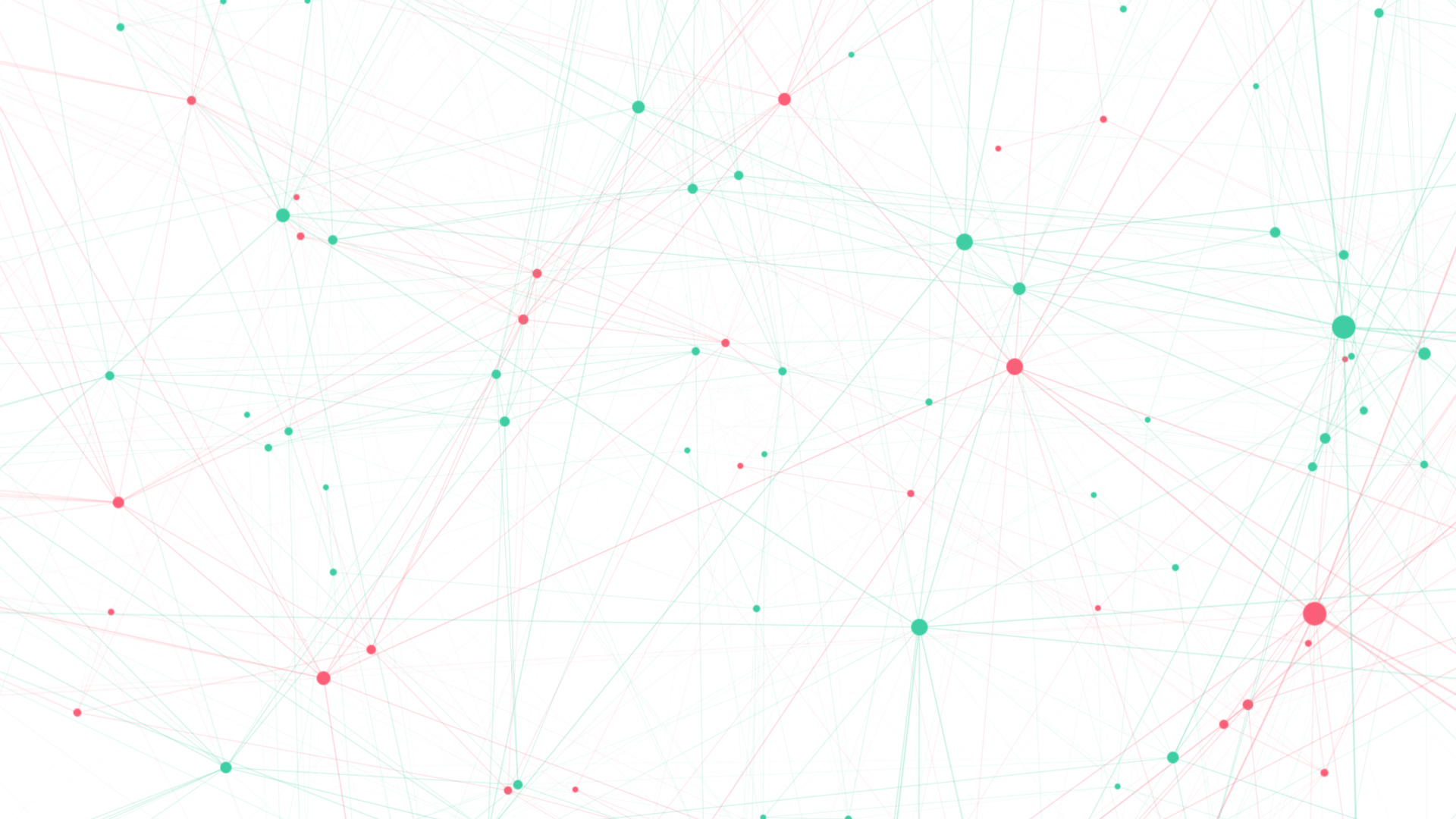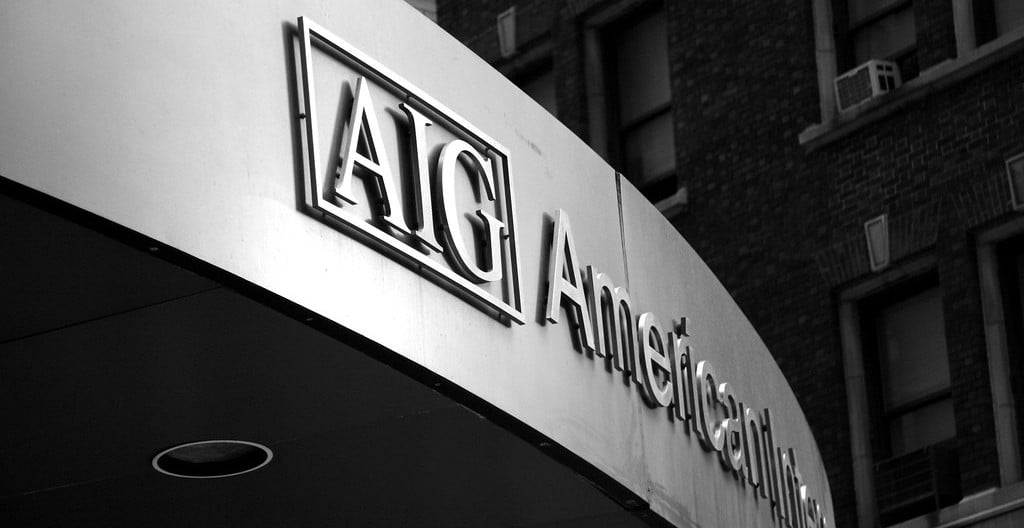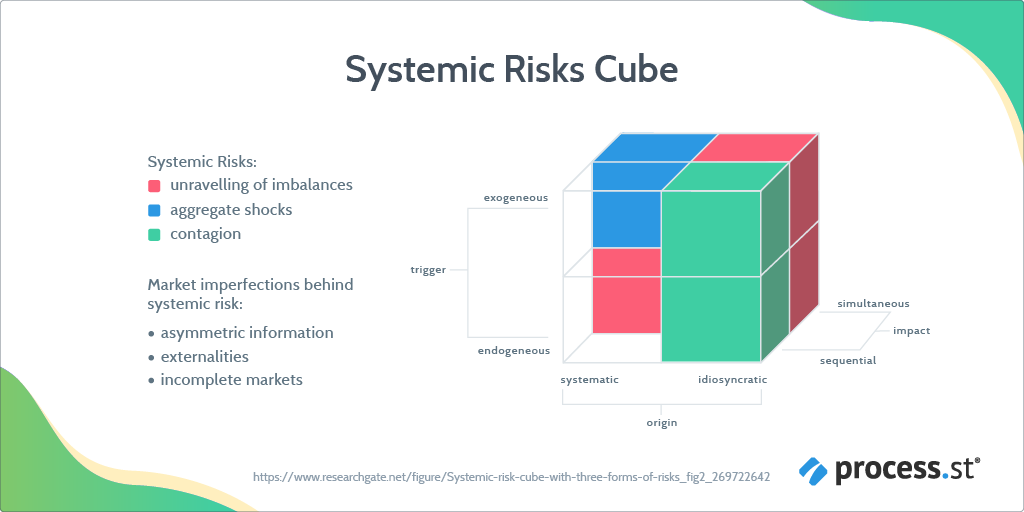
“They’re going to lose their houses, they’re going to lose their jobs…this is like, the end of capitalism, this is like the dark ages all over again” – The Big Short
Debuting in 2015, The Big Short is an American comedy-based drama showcasing the 2007-2008 financial crisis. I remember watching the movie, in quiet disbelief that a financial failure of such magnitude slipped through all areas of caution, potential management, and mitigation.
The 2008 financial crisis was the result of unsuccessful systemic risk management.
A crisis that the Federal Reserve Board estimated to have cost every single American ~$70,000.
For me, this single example communicates the importance of understanding, managing, and mitigating systemic risk items. With that in mind, we begin this article on systemic risk.
In this Process Street article, we will explain what systemic risk is and how it differs from conventional risk. You are given tips to help you identify prevailing systemic risks so you can be proactive, plan for, and manage these risks for your business and line of work.
Before concluding the article, we acknowledge climate change as a potent systemic risk that urgently needs to be addressed and managed. For this, we give you free template resources, uniquely designed to support the movement towards business sustainability. A movement that runs hand-in-hand with carbon footprint reduction.
Click on the relevant subheader below to jump to that section. Alternatively, scroll down to read all we have to say about systemic risk.
- Risk management: Conventional risk vs systemic risk
- Systemic risk: An explanation for the concept
- Systematic risk: The difference and its relation to systemic risk
- Systemic risk examples
- Identifying systemic risk elements: Too big to fail, too interconnected to fail
- Systemic risk mitigation: Approaches to managing systemic risk
- Global systemic risks of today, a new challenge
- Climate change as a systemic risk
- Using Process Street to become more sustainable, mitigating against climate change
Risk management: Conventional risk vs systemic risk
Risk management is about reducing uncertainty to a tolerable level. The process looks at what might go wrong and plans to manage and mitigate this.
The dawn of risk management as a practice has been a key factor driving economic growth and increasing welfare since the industrial revolution.
There is no doubt that risk management has made modern society safer. Predominantly by looking at conventional risks.
Before explaining what systemic risk is, we first need to understand conventional risks so we can see the difference between the two.
Understanding conventional risks
Conventional risks are risks that can be easily assessed in terms of impact and likelihood.
Examples of conventional risks in business include employee illness, safety risks, changes in consumer preference, increased competition, government policy changes, ect.
Due to the relative ease in defining them, conventional risks can be plugged into a risk management process for effective risk control.
Risk Management Process checklist
A risk management process is a set of steps enabling the identification, monitoring, and management of potential risks.
To help you manage and mitigate conventional risks in your line of work, Process Street has created a Risk Management Process checklist, given to you for free, below.
Create an account and click on the link to access our Risk Management Process checklist.
Click here to access our Risk Management Process!
Understanding systemic risks
Moving away from conventional risks, there is a growing awareness that within our modern society new risk types are emerging. These risks are harder to define in terms of likelihood and impact.
The 2008 global financial crisis adjusted the spotlight onto these new, emerging risks. Non-conventional in nature, the Organisation for Economic Co-operation and Development (OECD) produced a report on Emerging Systemic Risks to address these non-conventional risk elements.
The concept of systemic risk was originally coined by financial market specialists. Therefore, systemic risks were defined as non-conventional risks to economic and financial systems. However, over the years the definition of systemic risk has become broader.
The previously mentioned OECD report adapted the definition of systemic risk to include not just financial systems, but any system on which society depends. This is a point I will discuss towards the end of this article. For now, we take the view that systemic risk items are risks threatening economic and financial systems.
Systemic risk: An explanation for the concept

Although an accepted definition is lacking, in this article, I have defined systemic risk with the following perspective:
A systemic risk is an event that adversely impacts several systemically important intermediaries or markets.
Granted, that definition can cause brain fog. For clarity, let’s break it down together.
Systemic definition
Systemic means to concern a system.
A system is a complex whole comprised of interconnected mechanisms and procedures working together.
As per the definition above, the system under consideration is the financial system. With this view, systemic risk refers to the breakdown of the entire financial system due to a domino effect of negative events cascading to a severe economic downturn.
Risk definition
Risk is a term that many of you will already have a clear idea about. A risk is a situation that exposes danger.
Risk is measured in terms of likelihood and impact. As we have already mentioned, conventional risks are easily defined as per these attributes. Non-conventional, systemic risks, are more difficult to pin down.
Delving further into the definition of conventional risk is beyond the scope of this article. For more information, read the following resources:
- The Ultimate Risk Management Guide: Everything You Need to Know
- Why You Need a Risk Management Process (+Free Template)
- Risk Mitigation: What It Is and How to Implement It (Free Templates)
- Business Risk: The 3 Main Threats to Your Business and How You Can Manage Them
- What Is ISO 31000? Getting Started With Risk Management
Systematic risk: The difference and its relation to systemic risk
Right, now I’m going to spice things up and introduce you to another term, systematic risk.
“Systematic risk is that part of the total risk that is caused by factors beyond the control of a specific company or individual. Systematic risk is caused by factors that are external to the organization…Systematic risk cannot be diversified away by holding a large number of securities” – CFI, What is Systematic Risk?
Systemic and systematic risk explain two different forms of risk, yet the terms are often confused. It is important to grasp the difference and use the terms as appropriate.
For a simplistic summary, you can think of systemic risk as risk within a systems control and systematic risk as risk outside a system’s control. Depending on the system defined, determines what kind of risk you are dealing with.
Examples of systematic risks include:
- Macroeconomic factors, such as inflation, interest rates, currency fluctuations.
- Environmental factors, such as climate change, natural disasters, resource, and biodiversity loss.
- Social factors, such as wars, changing consumer perspectives, population trends.
The boundaries between systemic and systematic risk can become fuzzy. To re-iterate the point, explaining a risk as systemic or systematic is dependent on the system under consideration, asking the question: How much control does the system have on the risk item?
For this article, our coverage of systematic risk stops here. If you want to find out more about systematic risk, read:
- Multiscale systematic risk
- Systematic Risk of the Multinational Corporation
- Diversification on Strategy and Systematic Risk
- Systematic Risk, Total Risk, and Size as Determinants of Stock Market Returns
- Systematic Risk and Timescales
Systemic risk examples
Switching back to systemic risk, we will look at 3 examples illustrating how such risk items can cause the breakdown of an entire system. Defining the system, in these examples, we refer to the financial system as the convention.
Systemic risk example, #1: The 1866 Overend and Gurney collapse

Systemic risk ⚠: Severe economic downturn and collapse of the financial system.
Systemic risk item : A large brokerage firm, Overend and Gurney, which held a substantial economic slice from the financial system.
The 1802 London born brokerage firm, Overend and Gurney, ventured into high-risk lending, with a particular focus on the shipping industry. The repercussions of such were negative, forcing the firm into bankruptcy with denial of its bailout pleas by the Bank of England.
The impacts did not ripple, but huge tidal waves of panic spread through the entire financial system. Liquidity vanished, and even the market of relatively safe assets dried up.
The result : A severe recession in the British Economy.
Systemic risk example, #2: Lehmans Brothers

Systemic risk ⚠: Financial system failure, causing difficulties in getting loans and the freezing of capital markets.
Systemic risk item : Bankruptcy of Lehman Brothers Holdings Inc. A large , ↹interconnected↹ financial services firm.
Founded in 1847, Lehman Brothers Holdings Inc. grasped much of the global financial market. Before its bankruptcy, the company was the 4th largest financial services firm globally. Its 158-year operational reign, however, came to an end in 2008.
The result : The firms’ size and integration into the U.S. economy meant that the crash cascaded catastrophe in the financial system, freezing up the capital market and causing difficulties for people to get loans.
Systemic risk example, #3: AIG

Systemic risk ⚠: Collapse of the financial system and numerous financial institutions.
Systemic risk item : Bankruptcy of the multinational, ↹interconnected↹ finance and insurance corporation American International Group (AIG).
AIG has operations in over 80 countries and jurisdictions.
During the 2008 financial crisis, the Federal Reserve bailed AIG out for $180 million. AIG’s problems were due to mass sales and unhedged insurance.
Owed to its bailout, AIG stayed afloat in contrast to Lehman Brothers Holdings Inc and Overend and Gurney. Due to AIG’s interconnectedness, its collapse would have caused the failure of many other financial institutions.
The result : With AIG, government intervention propped the company up. An essential mediation, as AIG’s crash would have caused a severe economic downturn.
Identifying systemic risk elements: Too big to fail, too interconnected to fail
While illustrating the above examples, you may have noticed I had bolded the following terms:
- Large
- ↹Interconnected↹
Why?
Well, you see, these two terms are systemic risk elements. That is, companies can be classified as the following:
- Too big to fail
- Too interconnected to fail
These are two measurements indicating the degree by which a company is thought of as a systematic risk element.
Too big to fail companies are so deeply ingrained into the financial system that company failure would be disastrous to the economy.
Too interconnected to fail companies are so connected to other institutions that failure would probably lead to a huge turnover of the overall system.
Systemic risk mitigation: Approaches to managing systemic risk
From the three examples above, you can see how the failure of large, and/or interconnected companies threaten the collapse of the entire financial system. Systemic threats like these are an inevitable part of the market-based system.
Research of systemic risk elements creates awareness of financial system vulnerabilities. Granted, awareness is not always sufficient to predict a crisis, but appropriate responses can be managed and judged.
Familiarity with systemic risk will:
- Shorten decision-making time;
- Regarding investment, increase the probability of portfolio adjustment ahead of the game.
With these benefits, market-to-market losses and trading costs are reduced.
Keeping this in mind, how do we, as individuals, prepare and manage systemic risk?
Let’s find out!
Systemic risk mitigation: Approach #1, focusing on the weak spots
Predicting the timing and dynamics of a systemic crisis is hard.
This is because indicators of systemic risk items are slow-moving and have lagging lead-times ahead of the crisis.
A more achievable aim would be to predict whether a specific shock is escalatory or transitory after it has occurred. For this, the following criteria can be used:
- Vulnerability: Referencing the Minsky hypothesis, a period of low-market volatility will result in a build-up of leverage and risk until a tipping point. Market volatility is therefore a good indicator of shock escalation.
- Rarity: The rarer the event, the greater the lack of preparedness regarding the financial market.
Systemic risk mitigation: Approach #2, adjusting portfolios early
Regarding investment, there are two rational bases for adjusting positions to systemic risk: Information advantage and market stress.
As already mentioned, market volatility is a good predictor of shock escalation. Knowing the volatility of the market, therefore, provides information advantage.
Market stress looks at distress information in the financial system such as prices, correlations, and volatility.
Systemic risk mitigation: Approach #3, running with the herd
It can be judged as a rational decision to follow market trends. For example, research indicates that markets face a critical risk (for instance, a major bank is at risk of default), but will tell little regarding government bailout.
Information often disseminates in the market through prices, so it is recommended to trade in price direction.
For more information on how to mitigate systemic risk, read: Managing (systemic) risk, a post by Systemic Risk and Systematic Value.
Measuring systemic risk: Systemic risk decomposition
By measuring systemic risk, the vulnerability of a system can be determined. Although there is still ongoing research and debate to find an unrivaled systemic risk measure, the systemic risk cube detailed below is a popular model.
The systemic risk cube was first introduced by the European Central Bank, 2009 Financial Stability Review. The cube is a conceptual framework for the visualization of systemic risk. The cube is made up of three dimensions: Triggers, origins, and impacts.

- Triggers: This is what unleashes a crisis. A trigger could take the form of an exogenous shock, that is, an event outside the system (macro-economic shocks). Alternatively, the shock could occur from within the system and be endogeneous (banks).
- Origins: The origins of the trigger could be idiosyncratic, that is, limited and distinguished. Alternatively, the trigger origin could be widespread and systemic. The latter will have an extreme impact on the entire system, whilst the former will impact only a single portion of the system.
- Impact: Problems arising from the trigger events can be sequential or simultaneous in fashion.
The systemic risk cube provides a sort of measure. Determining system risks based on triggers, origins, and impact opens up an avenue for measuring systemic risk.
Global systemic risks of today, a new challenge
So far, our take on systemic risk has focussed on financial systems. However, coming back to that ⬆ OECD report ⬆, we learn the concept of systemic risk addresses a whole range of systems, not only financial.
It is with this point that confusion often arises, and means the first issue in addressing systemic risk is to define the system.
You see, following the financial crisis, it became apparent that there was a need to rein in systemic risks that had developed globally. In the OECD report, this included risks to financial systems, but also any other system in which society depended.
For instance, transportation, telecommunications, and environmental systems.
You can see how the interpretation of systemic risk is starting to get ambiguous.
Which begs the question, is there a need for a hard, set definition?
In my opinion, a single standardized definition is not essential, as long as clear, distinct, practically useful concepts are set. With this in mind, four major properties of systemic risks can be defined as follows:
- Systemic risks are global in nature.
- Systemic risks are highly interconnected and intertwined, leading to complex causal structures. ↹
- Systemic risks are non-linear in cause-effect relationships, often involving a tipping point, from which impacts cascade.
- Systemic risks are stochastic in their effect structure, meaning predicted outcomes will vary.
With this expanded definition in mind, we take a look at a significant, prevailing systemic risk threatening society today.
Climate change as a systemic risk
Systemic risk ⚠: The breakdown of our current climatic system.
Systemic risk item : The materialization of fossil fuel assets, that so far remain locked-up in the form of oil, coal, and gas.
Climate change as a risk respects no boundaries. The impacts are compounding and the modeled consequences severe.
As the realities of climate change creep from the shadows, are we treating this systemic risk too much as a fiction?
Since 1988, 50% of all human attributed CO2 has been released.
As we probe into the Earth’s surface, extracting fossil fuel assets to power our energy industry, we are slowly witnessing the damaging repercussions in the form of a degrading climatic system. The potential societal consequences of such could be devastating.
Also, the deterioration of our climatic system is cascading negative responses in other systems. Our financial system for one, as I explain.
Mapping the escalating trajectory of carbon dioxide release, the predicted climatic impacts could cost the U.S. economic system up to $23 trillion, with climate change property losses totaling $140 million in 2018, a figure anticipated to rise.
Assets of oil and gas companies are heavily governed by fossil fuel reserves. Judging by the current potential cost of climate change, and modeling future costs, the question arises: Would the disruption of our climatic system, through the combustion of fossil fuel reserves, cost the U.S. economy a lot more than gained from asset materialization?
For instance, decisions to leave remaining fossil fuel reserves are stated to fritter-away $900 billion in stranded energy assets.
Yet what is $900 billion relative to $23 trillion, the cost of climate change already realized?
Does this not, in effect, make oil and gas companies fiscally insolvent?
The result : Further fossil fuel extraction and reliance will degrade our climatic system, a system society depends on for stability, supporting our current way of life. The negative repercussions are cascading back to our financial system, coming full-circle, threatening the solvency of the very companies contributing to climate change – oil and gas.
As a systemic risk, climate change is something you can have a direct influence over as a business owner and employee. To help you achieve your goals, Process Street has 7 invaluable templates to be used right away, supporting greener and more sustainable business practices.
Using Process Street to become more sustainable and reduce your carbon footprint
Process Street is superpowered checklists.
If you are new to Process Street and a little unsure about what it is we offer, watch our below webinar: An Introduction to Process Street.
Below I have listed 7 top templates you can use to operate more sustainably for climate change mitigation. Using these templates, you will notice the following features:
- Stop tasks to ensure task order
- Dynamic due dates, so no deadline is missed
- Conditional logic, creating a dynamic template that caters to your needs
- Role assignments, to ease task delegation within your team
- Approvals, allowing decision-makers to give the go-ahead (or rejection) on important items
Hotel Sustainability Audit
Although the Hotel Sustainability Audit has been specifically designed to meet to needs of the leisure industry, you can easily edit this template for a process unique to your trade, whilst maintaining the core fundamentals.
Click here to access the Hotel Sustainability Audit
Environmental Accounting Internal Audit
Use this Environmental Accounting Internal Audit as a guide, supporting your small business accounting processes to attain and retain a sustainable focus.
Click here to access the Environmental Accounting Internal Audit checklist
Environmental Management Systems (EMS) Implementation Checklist Template
Use this Environmental Management System (EMS) Implementation Checklist Template to help you create a plan for the development and implementation of your Environmental Management System.
Click here to access the Environmental Management System (EMS) Implementation Checklist Template
ISO 14001 Environmental Management Self Audit Checklist
Run this checklist to perform an internal audit on an Environmental Management System (EMS) against the requirements set out in ISO 14001:2015.
Click here to access the ISO 14001 Environmental Management Self Audit Checklist
ISO 14001 EMS Structure Template
Use this template to build and maintain the requirements and standard operating procedures for an Environmental Management System (EMS) mini-manual in line with ISO 14001:2015 specifications for environmental management.
Click here to access the ISO 14001 EMS Structure Template
ISO 14001 EMS Mini-Manual Procedures
An ISO 14001:2015 compliant EMS mini-manual complete with requirements and standard operating procedures, created for Black Mesa Construction (a fictional construction company).
Click here to access the ISO 14001 EMS Mini-Manual Procedures
BSR Greenwash Prevention Checklist
Run our BSR Greenwash Prevention Checklist to follow the BSR guidelines and assess whether you are communicating your environmental efforts both honestly and effectively.
Click here to access our BSR Greenwash Prevention Checklist!
Adopting a sustainable business means stringently assessing each step of your business processes, asking how can I do this differently to be more sustainable? Documenting your business processes is vital for such exhaustive assessments.
You can document your business processes in a checklist format using Process Street. For more information on how to create and edit templates with Process Street, watch the below video: Basics of Creating and Editing Templates.
Use Process Street for systemic risk control in your business
In this article, we have defined the difference between conventional and non-conventional risks. Conventional risks are easily assessed in terms of impact and likelihood. Non-conventional risks are more difficult to define.
Systemic risk items are an example of non-conventional risks. When referring to systemic risks, it is important to define the system in reference. Systemic risk can refer to any system on which society depends.
In this sense, climate change is a systemic risk. Our climatic systems are being pushed into an unknown with the continual burning of fossil fuel reserves. This threatens our current way of life.
Also, the systemic threat of climate disruption cascades impacts on other systems. In this article, we explained how our financial systems are impacted by climate change in a sort of system-to-system interaction.
With this in mind, you have been given access to our 7 top templates to help you as a business owner or employee work to become more sustainable, and therefore, play your part to help mitigate the impacts of climate change.
For more information on business sustainability, read the following articles:
- Corporate Sustainability: Using System Thinking to Solve a Global Crisis
- Economic Sustainability For Success: What It Is And How To Implement It
- How You Can Create a Sustainable Business For Long-Term Success
- Greenwashing: What It Is and How to Stop It (Free Template)
- GRI Standards for Sustainability Reporting: What They Are and Why They Matter
- 5 Free ISO 14001 Checklist Templates for Environmental Management
- What is ISO 14000? EMS Basics & Implementation (Environmental Management)
Are you aware of systemic risk items that could impact your business or line of work? Climate change, as a systemic risk, is predicted to leave a daunting picture. With this is mind, how do you work to mitigate the risk of climate change? Please comment below as we would love to hear from you!







Jane Courtnell
Hi there, I am a Junior Content Writer at Process Street. I graduated in Biology, specializing in Environmental Science at Imperial College London. During my degree, I developed an enthusiasm for writing to communicate environmental issues. I continued my studies at Imperial College's Business School, and with this, my writing progressed looking at sustainability in a business sense. When I am not writing I enjoy being in the mountains, running and rock climbing. Follow me at @JaneCourtnell.